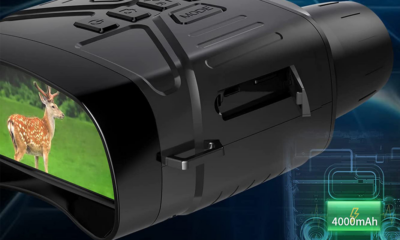Gadgets
5 coolest engineering innovations of 2024

To limit global temperature rise to less than 1.5 degrees Celsius, emissions need to be halved by 2035, even as record levels of fossil fuels are being burned. The innovative engineering showcased in this year’s award-winning projects offers hope that we can meet this challenge. New technologies, such as a thermal battery and laser-based iron production, are paving the way for decarbonization in various industries. From creating biochar from agricultural waste to developing precision pest control methods, these advancements are driving sustainability forward.
(Editor’s Note: This is a section from Popular Science’s 37th annual Best of What’s New awards. Be sure to read the full list of the 50 greatest innovations of 2024.)
Grand Award Winner
Joule Hive “firebrick” thermal battery by Electrified Thermal Solutions (ETS): A cleaner 21st-century firebrick
The Joule Hive is a groundbreaking thermal battery that can maintain high temperatures using clean electricity. By harnessing the power of ancient firebrick technology, this innovation has the potential to revolutionize energy-intensive industries like cement and steel production. The use of metal oxides in the firebricks allows for efficient heat storage and distribution, offering a sustainable alternative to fossil fuel-based heating methods.
The innovative design of the Joule Hive sets it apart from traditional heating elements by offering greater efficiency and reduced maintenance requirements. Studies suggest that widespread adoption of this technology could significantly reduce CO2 emissions from heavy industries worldwide. Electrified Thermal Solutions plans to deploy the Joule Hive on a commercial scale in 2025, starting with a pilot project in San Antonio.
Mobile biochar farm robot by Applied Carbon: Gathering agricultural waste and turning it into biochar in the field

Applied Carbon has developed a mobile robot that can efficiently convert agricultural waste into biochar in the field. By utilizing pyrolysis technology, this robot can process a variety of organic materials, including crop residues, into biochar, a stable form of carbon that helps sequester carbon dioxide. The on-site production of biochar reduces transportation emissions and offers a sustainable solution for managing agricultural waste.
The scalability of this technology allows for large-scale carbon sequestration, potentially offsetting billions of tons of CO2 emissions annually. Through innovative approaches like these, companies like Applied Carbon are driving towards a more sustainable future.
Co-founder Jason Aramburu jokingly compares his upcoming vehicles to Jawa crawlers from Star Wars, but instead of scavenging for dead robots, they will scavenge for stalks and corncobs.
Limelight Steel, based in Oakland, is utilizing the “Moore’s Law of lasers” to revolutionize iron ore processing for steel production, resulting in a 95% reduction in emissions. By directing laser light onto ore surfaces, Limelight Steel breaks the bonds between iron and oxygen without the need for carbon or expensive green hydrogen. This innovative process aims to significantly reduce the environmental impact of steel production, which currently accounts for about 8% of global emissions. Limelight has demonstrated that when powered by renewable electricity, their steelmaking process produces 95% fewer emissions than traditional methods. With the help of a $2.9 million grant from ARPA-E, they have proven the concept and are now planning to build a pilot-scale plant in 2025 that can produce 100 tons of steel annually. This innovative approach not only reduces carbon footprint but also shows promise for a more sustainable future in the steel industry. Please rewrite this sentence.
-

 Destination7 months ago
Destination7 months agoSingapore Airlines CEO set to join board of Air India, BA News, BA
-

 Breaking News8 months ago
Breaking News8 months agoCroatia to reintroduce compulsory military draft as regional tensions soar
-

 Tech News10 months ago
Tech News10 months agoBangladeshi police agents accused of selling citizens’ personal information on Telegram
-

 Breaking News8 months ago
Breaking News8 months agoBangladesh crisis: Refaat Ahmed sworn in as Bangladesh’s new chief justice
-

 Guides & Tips9 months ago
Guides & Tips9 months agoHave Unlimited Korean Food at MANY Unlimited Topokki!
-

 Gaming8 months ago
Gaming8 months agoThe Criterion Collection announces November 2024 releases, Seven Samurai 4K and more
-

 Toys10 months ago
Toys10 months ago15 of the Best Trike & Tricycles Mums Recommend
-

 Tech News9 months ago
Tech News9 months agoSoccer team’s drone at center of Paris Olympics spying scandal
























